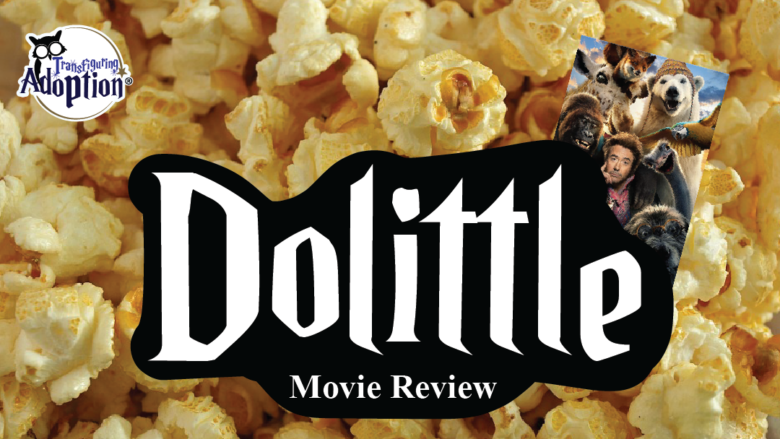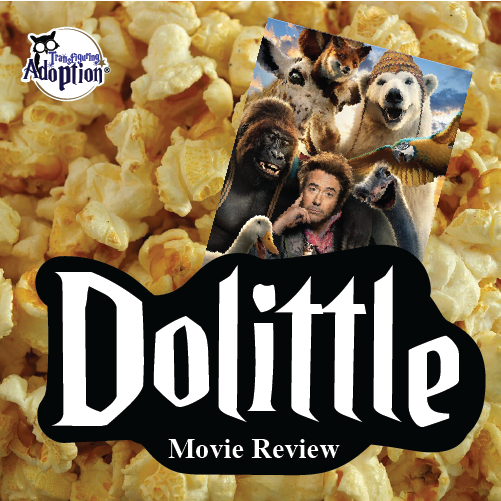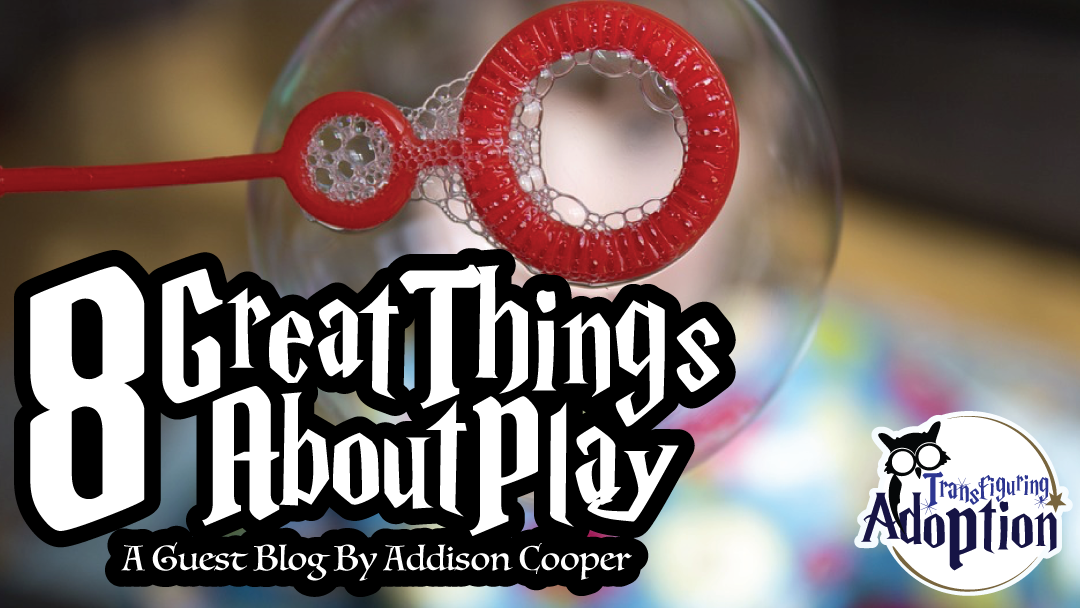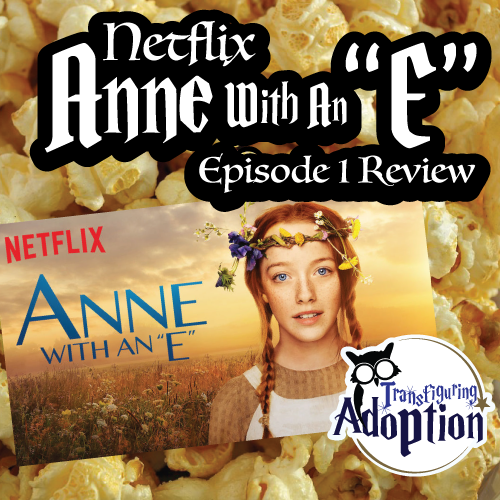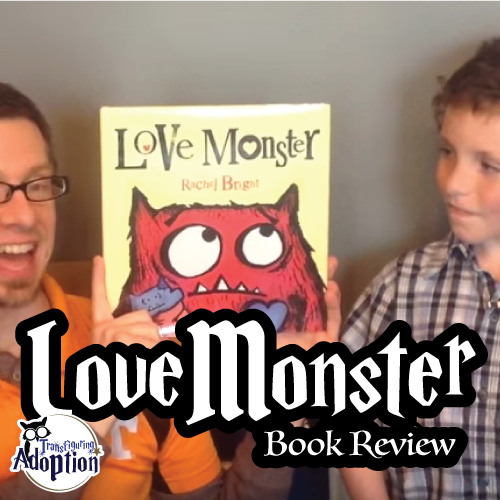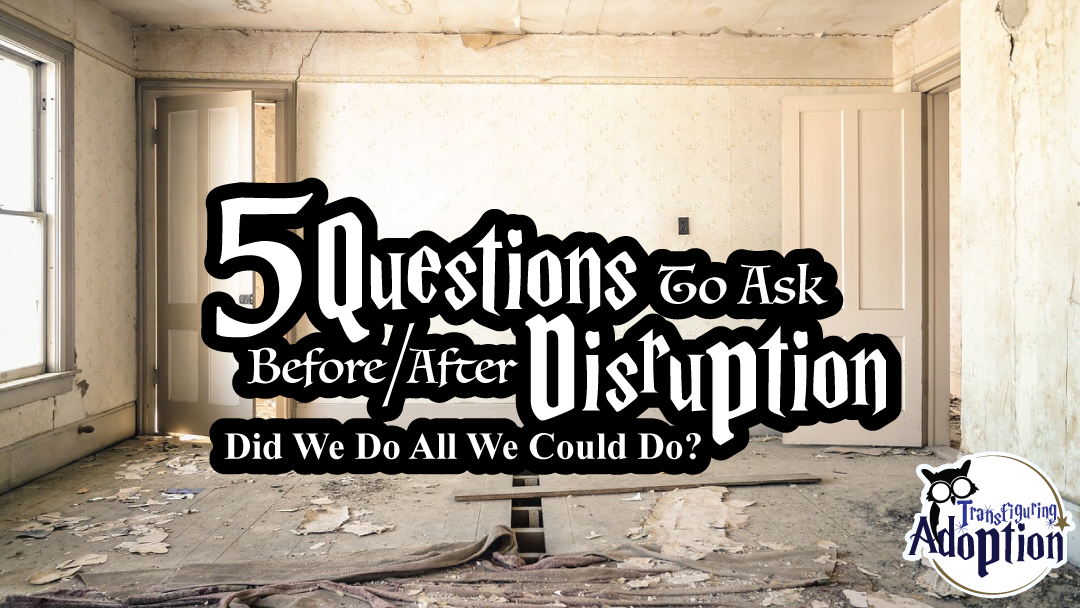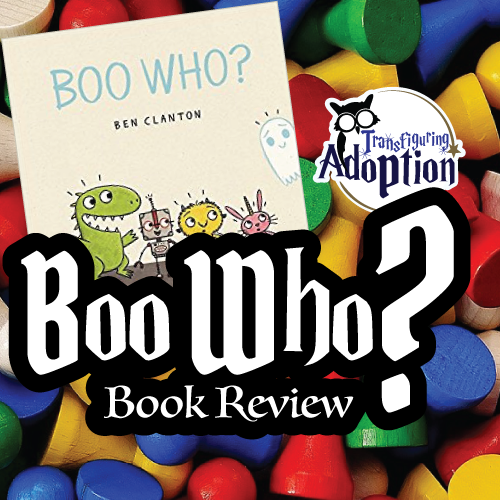Grade:
Transfiguring Adoption awarded this movie 3 Hoots out of 5 based on how useful it will be for a foster/adoptive family. [Learn more about our Hoot grading system here]
Movie Info:
From the Cover of Dolittle by Universal Pictures:
“After losing his wife seven years earlier, the eccentric Dr. John Dolittle (Robert Downey Jr.), famed doctor and veterinarian of Queen Victoria’s England, hermits himself away behind the high walls of Dolittle Manor with only his menagerie of exotic animals for company. But when the young queen falls gravely ill, a reluctant Dolittle is forced to set sail on an epic adventure to a mythical island in search of a cure, regaining his wit and courage as he crosses old adversaries and discovers wondrous creatures. The doctor is joined on his quest by a young, self-appointed apprentice (Dunkirk’s Harry Collett) and a raucous coterie of animal friends.”
“Dolittle” boasts a pretty star-studded cast list, including the first role we’ve seen Robert Downey Jr. in since the Avenger’s decade wrapped up last May. He brings an interesting and quirky take to the character of Dolittle and is joined for an adventure by a gang of his furry friends and a young boy who is struggling to figure out his place in the world. The movie has some promising themes about friendship, fitting in, and facing your fears and would be enjoyable for older elementary aged kids (7-10) who enjoy adventure and talking animals. While there is some violence and moments of mild peril, the film has a swashbuckling feel along the lines of “The Princess Bride” or “Indiana Jones”, rather than a typical action/shoot-em-up movie.
** Spoilers Could Be Ahead **
How Is This Relevant To Adoption & Foster Care?
The basic premise of Dolittle’s sanctuary is that it’s a home for all creatures large or small and no one is turned away. While it is more of an animal shelter, due to Dolittle’s ability to converse with them, these animals take on many anthropomorphic qualities and are more similar to people in many ways. These animals that Dolittle has taken in are his ‘family of choice’. This theme of found family and not turning anyone away may resonate with children from foster and adoptive backgrounds since often the thing they want most is a ‘sanctuary’- a safe home with people to care for them and help them to heal.
As a character, Dolittle may also be relatable to children in care. At the start of the movie we find out he has lost his beloved wife and essentially become a hermit shutting himself off from the world, aside form his few trusted animal friends. He is reluctant to trust others and fears being hurt again. Children who are in care have often been hurt by the people who were supposed to love them the most. Because of that, they may be resistive to becoming part of a family again because they worry that this new family will hurt them just like they were hurt before. Watching Dolittle learn to trust and let others into his circle again may mirror feelings and experiences they have had.
Discussion Points:
- Trusting Others
After the death of his wife, Dolittle becomes a recluse and stays in his house hiding from the world with his animal friends. When a young boy comes knocking at his door, Dolittle hides from him saying, “if you let people in, they’ll hurt you.” Over the course of the movie Dolittle slowly learns to trust other people again and eventually welcomes Stubbins into his ‘family’. Children with backgrounds of foster care and adoption have often been hurt by those who were supposed to love them the most. This can cause them to become fearful and distrusting of everyone as a result. When they first come into a foster or adoptive home, they most likely are reluctant to let themselves become a part of a family again, for fear that they will be hurt like they were before. Talking about Dolittle’s feelings at the start of the movie and his journey to opening up and letting others in again after he’s been hurt can be a good way to help youth come to terms with their own journeys on this path towards trust. - Embracing and Overcoming Fears
Another frequent theme that comes up during the movie is the idea of facing your fears. This is especially seen in the character of Chee-Chee, a gorilla who seems to have a lot of anxiety. Dolittle tells him a number of times, ‘it’s okay to be scared!’ and “you’re not a prisoner of fear”. There are a few times in the movie where Chee-Chee’s fear gets the better of him and he freezes up. However, in the end he is able to embrace his fear and work through it, and as a result saves Dolittle from a dangerous situation. This can be a great opportunity to talk to kids about their own fears and how it’s okay and understandable for them to have things that they’re afraid of. But also talking about how use that fear in a healthy way, rather than letting it keep them from experiencing or accomplishing things. - Dealing with Loss/Emotional Pain
A central theme during the movie is that of losing a loved one. Dolittle lost his wife and is still grieving her, and towards the end of the film we are introduced to a dragon character who we find out has lost her mate. She tells Dolittle, “you know nothing of my pain” when he first approaches her. Kids in care can often feel like this, like you couldn’t possibly understand how they feel because you haven’t been through the same things they have. The dragon also says her feelings are worse than any physical pain and that “it cuts much deeper in every moment you feel it again”. Our kids who have been through foster care or adoption likely have things in their past that feel like this. This can be an opportunity to talk about those feelings. Even if they aren’t ready to talk about why they are hurting, just opening up to admit that they are hurting can be an important first step.
Cautionary Points:
- Death of a Main Character/Mother Figure:
The movie opens with the audience learning that Dolittle’s wife has died in a shipwreck, and he has become a recluse, shutting himself up in his home with his family of animals. Dolittle and his wife did not have human children, but they treat their animal friends as their family and in a way, these are their children. Hearing about her death and watching Dolittle and the animals react to the death of their mother figure and deal with the aftermath of that may be difficult for children who have experienced similar situations. - Mild Peril/Violence
There are a number of action sequences throughout the movie that involve some violence (primarily swords and fighting). However, the movie had a very over-the-top, swashbuckling sort of tone (think “The Princess Bride” or “Pirates of the Caribbean”) so the violence doesn’t feel particularly realistic and is almost cartoonish. There are also a few scenes where it appears as if something bad is going to happen to the main characters, which may be anxiety-producing. - Character is Forcibly Restrained
There is a scene towards the beginning of the movie where Dolittle is going to meet the queen. He’s let himself go quite a bit physically, and his animal friends want to give him a makeover, but he does not want to. They use anesthesia to essentially knock him out so they can give him a bath and a haircut. Personal grooming can often be a point of contention with children with a background of adoption or foster care. For those who have suffered physical abuse, they may be fearful of activities such as haircuts or bathing. Or it can also be a defense mechanism for youth who have suffered sexual abuse. In either case, watching a character being held down or knocked out while these things are done to them could enhance those fears or aversions. - Child is Left Behind
Stubbins desperately wants to go on the adventure with Dolittle and the animals but Dolittle does not want him to. Dolittle goes as far as to set sail while Stubbins is still sleeping in an attempt to leave him behind. He is awoken by another character, runs after the boat and is able to catch up and come along. And while Stubbins isn’t Dolittle’s child, the scene may still be upsetting to children who have been abandoned or left behind by their family. - Drowning
There is a scene near the end of the movie where Dolittle’s ship is hit by a cannon ball and sinks while many of the animals are still on board. There is a scene where the animals are in the water panicking because some of them don’t know how to swim. It is short-lived and all of the animals are able to help one another and get to shore safely. However, for children who have fears of the water or who have experienced a natural disaster involving flooding or water it may be upsetting. - Magical Healing
The movie centers around a quest to find a magical fruit that cures any illness. While this is a common trope in fantasy literature, it can be harmful to some children to lead them to believe that something like this exists. Children may struggle if they know of someone who is ‘sick’ and wonder why that person can’t just take the right medicine and be magically cured. In terms of foster care, often times when parents are drug addicts or have other mental health issues that lead to children being taken into care, it’s explained to them that the parent is ‘too sick’ to take care of them right now and that they might be able to go home when they ‘get better’.
Discussion Guide:
- Which of Dolittle’s Animal Friends was your favorite? Why?
[CAREGIVER NOTE: This question is primarily for bonding and just a low-key way to get the conversation going and lead into the next question.]
- Was there a character you felt like you could relate to? Why?
[CAREGIVER NOTE: Each of the main characters is dealing with a different struggle: Dolittle is learning how to trust the world again after a devastating loss, Stubbins feels like he doesn’t fit in and longs to find a place where he is accepted, and Chee-Chee is dealing with anxiety and how to not be a ‘prisoner of fear’. Depending on the development of the child, they may not be able to articulate why a particular character resonated the most with them, but by choosing one of the above it may indicate that they are struggling with something similar].
- When Stubbins and Lady Rose arrive at Dolittle Manor, Dr. Dolittle hides and refuses to answer the door. Why is he so afraid of meeting new people?
[CAREGIVER NOTE: Dolittle struggled after losing his wife and retreated from the world because it was too painful. He worries that if he meets new people and cares about them, he’ll be hurt again, and he doesn’t want to feel that pain anymore. This can be a great way to start a conversation about how vulnerability and getting close to new people can be scary but that in the end it’s worth it to experience the love and other good things relationship can bring.]
- Have you ever felt that way about meeting new people? What would help you in situations like this in the future?
[CAREGIVER NOTE: This question may be one that is difficult for children to answer, especially those who are newer to care and who may still be in the fearful phase. If this is the case maybe suggest things that might be helpful or things that have helped you. This likely looks different for every child but maybe having a special place like their room or another safe location where they can go when they feel overwhelmed, or a familiar item they can have with them when meeting someone new.]
- In the movie Dolittle and his crew take a ship voyage to search for a hidden island where the special fruit grows that will heal the Queen. If you could create your own secret island, what would it be like?
[CAREGIVER NOTE: This question is just another fun opportunity to do some creative brainstorming together. There are some meditation techniques that use a ‘special place’ as means of focus so maybe the island you create with the child could be their special safe place they can think of. It can also be an opportunity to learn about what’s important to them and what the ‘perfect place’ would be like for them.]
- ACTIVITY: Map Making- Going along with the above question, draw a map of how to get to your hidden island or of the island’s layout.
[CAREGIVER NOTE: This can be a fun way to visualize the island in conjunction with the previous question, especially for younger children. However older children and teens may also like drawing out maps and routes of how one would travel to get there.]
- Throughout the movie Dolittle and his crew face adventures and problems that they have to solve and often have to work together in order to get past these obstacles and each character has unique traits that they bring to the team. What are some ways they use their individual strengths to work as a team?
[CAREGIVER NOTE: There are a number of examples in the movie they can choose from here- when the animals help Stubbins get on the boat, how Dolittle enlists the help of the octopus and stick insect to uncover the poisoning plot, the way the dragonfly and Stubbins help get the journal, how the animals help each other after the shipwreck, etc. Be sure to talk about how each character has different special skills that they are able to use to best help the team. For example, the stick insect blends in so he could hide behind the painting, the whale is strong and can pull the boat along, Stubbins is small so he can slip between the dungeon bars. None of the characters would be able to overcome the obstacles on their own, it takes the unique strengths of everyone working together to succeed].
- The dragon tried to hurt Dolittle and his friends, and yet when he realizes that the dragon is sick and needs help, Dolittle is still willing to try and help her. Why do you think this is?
[CAREGIVER NOTE: It’s easy when we are hurt to lash back at those who hurt us and to seek revenge. And kids with foster and adoptive backgrounds have been hurt plenty and it’s easy to become angry and to hurt others the way they were hurt. This is a good opportunity to talk about trying to understand where others are coming from and that everyone deserves help and compassion, and that hurting others back doesn’t make us hurt any less.
- The dragon has lost her mate and is very upset, so upset that it has made her physically sick because she’s been so stressed out and upset for a long time. Have you ever felt like that?
[CAREGIVER QUESTION: As with the question we asked earlier, children many not be in a place where they are ready to talk about this or even able to articulate how they feel. But talking about the physical symptoms that often go along with emotional pain (upset stomach, headaches, gastrointestinal distress) as evidenced by the dragon’s stomach pains in this scene may help children to understand the relationship between how their bodies feel and their emotions. ]
- All through the movie, Dolittle wears a special necklace/charm that belonged to his wife. However, after they reach the island and accomplish their mission, he leaves the necklace behind because he ‘no longer needs it’. What do you think he means by this?
[CAREGIVER NOTE: In many ways this necklace is similar to a security blanket for Dolittle- it makes him feel safe and like his wife Lily is still with him. During the course of the movie he learns to let others in again and builds a positive relationship with Stubbins. He realizes that his wife is always with him in his heart and he no longer needs the physical reminder of her because he’s reached a place of healing. This can be an opportunity to talk about some of the stages of grief and the steps Dolittle was able to take to get to this place of healing.]
About the Author: Jenn Ehlers
Jenn is a central Virginia native who received her BA in Psychology from the University of Virginia in 2012. Since then she has worked for a local mental health agency and the Department of Social Services in various capacities and has been involved in her community’s efforts to create a Trauma Informed Network. Currently Jenn works in vocational rehab and mentors youth in foster care. When she isn’t working, Jenn enjoys writing stories, anything and everything Harry Potter, and spending time with her niece and nephew.
**Transfiguring Adoption is a nonprofit organization seeking to nurture growth in foster and adoptive families by giving a HOOT about their families. Transfiguring Adoption does not intend for its reviewers nor its review to be professional, medical or legal advice. These reviews and discussion guides are intended to help parents to better be able to connect and understand their children who come from traumatic backgrounds.
